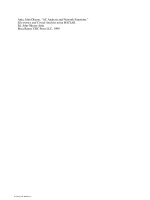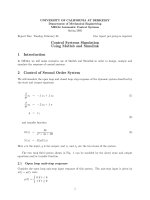Tài liệu Electronics Circuit Analysys Using Matlab P11 docx
Bạn đang xem bản rút gọn của tài liệu. Xem và tải ngay bản đầy đủ của tài liệu tại đây (310.34 KB, 35 trang )
Attia, John Okyere. “Operational Amplifiers.”
Electronics and Circuit Analysis using MATLAB.
Ed. John Okyere Attia
Boca Raton: CRC Press LLC, 1999
© 1999 by CRC PRESS LLC
CHAPTER ELEVEN
OPERATIONAL AMPLIFIERS
The operational amplifier (Op Amp) is one of the versatile electronic circuits.
It can be used to perform the basic mathematical operations: addition, subtrac-
tion, multiplication, and division. They can also be used to do integration and
differentiation. There are several electronic circuits that use an op amp as an
integral element. Some of these circuits are amplifiers, filters, oscillators, and
flip-flops. In this chapter, the basic properties of op amps will be discussed.
The non-ideal characteristics of the op amp will be illustrated, whenever possi-
ble, with example problems solved using MATLAB.
11.1 PROPERTIES OF THE OP AMP
The op amp, from a signal point of view, is a three-terminal device: two inputs
and one output. Its symbol is shown in Figure 11.1. The inverting input is
designated by the ‘-’ sign and non-inverting input by the ‘+’ sign.
Figure 11.1 Op Amp Circuit Symbol
An ideal op amp has an equivalent circuit shown in Figure 11.2. It is a differ-
ence amplifier, with output equal to the amplified difference of the two inputs.
An ideal op amp has the following properties:
• infinite input resistance,
• zero output resistance,
• zero offset voltage,
• infinite frequency response and
• infinite common-mode rejection ratio,
• infinite open-loop gain, A.
© 1999 CRC Press LLC
© 1999 CRC Press LLC
V
1
V
2
- A(V
2
- V
1
)
Figure 11.2 Equivalent Circuit of an Ideal Op Amp
A practical op amp will have large but finite open-loop gain in the range from
10
5
to 10
9
. It also has a very large input resistance 10
6
to 10
10
ohms. The out-
put resistance might be in the range of 50 to 125 ohms. The offset voltage is
small but finite and the frequency response will deviate considerably from the
infinite frequency response. The common-mode rejection ratio is not infinite
but finite. Table 11.1 shows the properties of the general purpose 741 op
amp.
Table 11.1
Properties of 741 Op Amp
Property
Value (Typical)
Open Loop Gain 2x10
5
Input resistance 2.0 M
Output resistance
75 Ω
Offset voltage 1 mV
Input bias current 30 nA
Unity-gain bandwidth 1 MHz
Common-mode rejection ratio 95 dB
Slew rate
0.7 V/µV
Whenever there is a connection from the output of the op amp to the inverting
input as shown in Figure 11.3, we have a negative feedback connection
© 1999 CRC Press LLC
© 1999 CRC Press LLC
Z
2
Z
1
I
2
I
1
(a)
Z
2
Z
1
I
2
I
1
(b)
Figure 11.3 Negative Feedback Connections for Op Amp
(a) Inverting (b) Non-inverting configurations
With negative feedback and finite output voltage, Figure 11.2 shows that
()
VAVV
O
=−
21
(11.1)
Since the open-loop gain is very large,
()
VV
V
A
O
21
0
−=≅
(11.2)
© 1999 CRC Press LLC
© 1999 CRC Press LLC
Equation (11.2) implies that the two input voltages are also equal. This condi-
tion is termed the concept of the virtual short circuit. In addition, because of
the large input resistance of the op amp, the latter is assumed to take no cur-
rent for most calculations.
11.2 INVERTING CONFIGURATION
An op amp circuit connected in an inverted closed loop configuration is shown
in Figure 11.4.
I
1
I
2
Z
1
Z
2
V
o
V
in
Z
in
V
a
A
Figure 11.4 Inverting Configuration of an Op Amp
Using nodal analysis at node A, we have
VV
Z
VV
Z
I
ain aO
−
+
−
+=
12
1
0
(11.3)
From the concept of a virtual short circuit,
VV
ab
==
0
(11.4)
and because of the large input resistance,
I
1
= 0. Thus, Equation (11.3) sim-
plifies to
V
V
Z
Z
O
IN
=−
2
1
(11.5)
© 1999 CRC Press LLC
© 1999 CRC Press LLC
The minus sign implies that
V
IN
and
V
0
are out of phase by 180
o
. The input
impedance,
Z
IN
,
is given as
Z
V
I
Z
IN
IN
==
1
1
(11.6)
If
ZR
11
=
and
ZR
22
=
,
we have an inverting amplifier shown in Figure
11.5.
V
o
V
in
R
2
R
1
Figure 11.5 Inverting Amplifier
The closed-loop gain of the amplifier is
V
V
R
R
O
IN
=−
2
1
(11.7)
and the input resistance is
R
1
. Normally,
R
2
>
R
1
such that
VV
IN
0
>
.
With the assumptions of very large open-loop gain and high input resistance,
the closed-loop gain of the inverting amplifier depends on the external com-
ponents
R
1
,
R
2
, and is independent of the open-loop gain.
For Figure 11.4, if
ZR
11
=
and
Z
jwC
2
1
=
,
we obtain an integrator
circuit shown in Figure 11.6. The closed-loop gain of the integrator is
V
V jwCR
O
IN
=−
1
1
(11.8)
© 1999 CRC Press LLC
© 1999 CRC Press LLC
V
o
V
in
C
R
1
I
C
I
R
Figure 11.6 Op Amp Inverting Integrator
In the time domain
V
R
I
IN
R
1
=
and
IC
dV
dt
C
O
=−
(11.9)
Since
II
RC
=
() () ()
Vt
RC
Vtd V
OIN
t
O
=− +
∫
1
0
1
0
τ
(11.10)
The above circuit is termed the Miller integrator. The integrating time con-
stant is
CR
1
.
It behaves as a lowpass filter, passing low frequencies and at-
tenuating high frequencies. However, at dc the capacitor becomes open cir-
cuited and there is no longer a negative feedback from the output to the input.
The output voltage then saturates. To provide finite closed-loop gain at dc, a
resistance
R
2
is connected in parallel with the capacitor. The circuit is shown
in Figure 11.7. The resistance
R
2
is chosen such that
R
2
is greater than
R
.
© 1999 CRC Press LLC
© 1999 CRC Press LLC
V
o
V
in
C
R
1
R
2
Figure 11.7 Miller Integrator with Finite Closed Loop Gain at DC
For Figure 11.4, if
Z
jwC
1
1
=
and
ZR
2
=
,
we obtain a differentiator cir-
cuit shown in Figure 11.8. From Equation (11.5), the closed-loop gain of the
differentiator is
V
V
jwCR
O
IN
=−
(11.11)
V
o
V
in
C
R
1
I
R
I
C
Figure 11.8 Op Amp Differentiator Circuit
In the time domain
IC
dV
dt
C
IN
=
, and
()
Vt IR
OR
=−
(11.12)
Since
© 1999 CRC Press LLC
© 1999 CRC Press LLC
() ()
It It
CR
=
we have
()
()
Vt CR
dV t
dt
O
IN
=−
(11.13)
Differentiator circuits will differentiate input signals. This implies that if an
input signal is rapidly changing, the output of the differentiator circuit will ap-
pear “ spike-like.”
The inverting configuration can be modified to produce a weighted summer.
This circuit is shown in Figure 11.9.
R
1
R
2
R
F
R
n
I
n
I
F
V
1
V
2
V
n
I
1
I
2
V
o
Figure 11.9 Weighted Summer Circuit
From Figure 11.9
I
V
R
I
V
R
I
V
R
n
n
n
1
1
1
2
2
2
== =
, , ,
(11.14)
also
III I
FN
=++
12
(11.15)
VIR
OFF
=−
(11.16)
Substituting Equations (11.14) and (11.15) into Equation (11.16) we have
© 1999 CRC Press LLC
© 1999 CRC Press LLC
V
R
R
V
R
R
V
R
R
V
O
FF F
N
N
=− + +
1
1
2
2
(11.17)
The frequency response of Miller integrator, with finite closed-loop gain at dc,
is obtained in the following example.
Example 11.1
For Figure 11.7, (a ) Derive the expression for the transfer function
V
V
jw
o
in
()
.
(b) If
C
= 1 nF and
R
1
= 2KΩ, plot the magnitude response for
R
2
equal to
(i) 100 KΩ, (ii) 300KΩ, and (iii) 500KΩ.
Solution
ZR
sC
R
sC R
22
2
2
22
1
1
==
+
(11.18)
ZR
11
=
(11.19)
V
V
s
R
R
sC R
o
in
()
=
−
+
2
1
22
1
(11.20)
V
V
s
CR
s
CR
o
in
()
=
−
+
1
1
21
22
(11.21)
MATLAB Script
% Frequency response of lowpass circuit
c = 1e-9; r1 = 2e3;
r2 = [100e3, 300e3, 500e3];
n1 = -1/(c*r1); d1 = 1/(c*r2(1));
num1 = [n1]; den1 = [1 d1];
w = logspace(-2,6);
h1 = freqs(num1,den1,w);
f = w/(2*pi);
© 1999 CRC Press LLC
© 1999 CRC Press LLC
d2 = 1/(c*r2(2)); den2 = [1 d2];
h2 = freqs(num1, den2, w);
d3 = 1/(c*r2(3)); den3 = [1 d3];
h3 = freqs(num1,den3,w);
semilogx(f,abs(h1),'w',f,abs(h2),'w',f,abs(h3),'w')
xlabel('Frequency, Hz')
ylabel('Gain')
axis([1.0e-2,1.0e6,0,260])
text(5.0e-2,35,'R2 = 100 Kilohms')
text(5.0e-2,135,'R2 = 300 Kilohms')
text(5.0e-2,235,'R2 = 500 Kilohms')
title('Integrator Response')
Figure 11.10 shows the frequency response of Figure 11.7.
Figure 11.10 Frequency Response of Miller Integrator with Finite
Closed-Loop Gain at DC
© 1999 CRC Press LLC
© 1999 CRC Press LLC
11.3 NON-INVERTING CONFIGURATION
An op amp connected in a non-inverting configuration is shown in Figure
11.11.
Z
2
Z
1
I
1
V
o
V
a
V
in
Z
in
A
Figure 11.11 Non-Inverting Configuration
Using nodal analysis at node A
V
Z
VV
Z
I
aaO
12
1
0
+
−
+=
(11.22)
From the concept of a virtual short circuit,
VV
IN a
=
(11.23)
and because of the large input resistance (
i
1
= 0 ), Equation (11.22) simplifies
to
V
V
Z
Z
O
IN
=+
1
2
1
(11.24)
The gain of the inverting amplifier is positive. The input impedance of the
amplifier
Z
IN
approaches infinity, since the current that flows into the posi-
tive input of the op-amp is almost zero.
© 1999 CRC Press LLC
© 1999 CRC Press LLC
If Z
1
=
R
1
and Z
2
=
R
2
, Figure 11.10 becomes a voltage follower with gain.
This is shown in Figure 11.11.
V
o
V
in
R
2
R
1
Figure 11.12 Voltage Follower with Gain
The voltage gain is
V
V
R
R
O
IN
=+
1
2
1
(11.25)
The zero, poles and the frequency response of a non-inverting configuration
are obtained in Example 11.2.
Example 11.2
For the Figure 11.13 (a) Derive the transfer function. (b) Use MATLAB to
find the poles and zeros. ( c ) Plot the magnitude and phase response, assume
that
C
1
= 0.1uF,
C
2
= 1000 0.1uF,
R
1
= 10KΩ, and
R
2
= 10 Ω.
V
o
V
in
R
2
R
1
V
1
C
1
C
2
Figure 11.13 Non-inverting Configuration
© 1999 CRC Press LLC
© 1999 CRC Press LLC
Solution
Using voltage division
V
V
s
sC
RsC
IN
11
11
1
1
()
=
+
(11.26)
From Equation (11.24)
V
V
s
R
sC
O
1
2
2
1
1
()
=+
(11.27)
Using Equations (11.26 ) and (11.27), we have
V
V
s
sC R
sC R
O
IN
()
=
+
+
1
1
22
11
(11.28)
The above equation can be rewritten as
()
V
V
s
CR s
CR
CR s
CR
O
IN
=
+
+
22
22
11
11
1
1
(11.29)
The MATLAB program that can be used to find the poles, zero and plot the
frequency response is as follows:
diary ex11_2.dat
% Poles and zeros, frequency response of Figure 11.13
%
%
c1 = 1e-7; c2 = 1e-3; r1 = 10e3; r2 = 10;
% poles and zeros
b1 = c2*r2;
a1 = c1*r1;
num = [b1 1];
den = [a1 1];
disp('the zero is')
z = roots(num)
© 1999 CRC Press LLC
© 1999 CRC Press LLC
disp('the poles are')
p = roots(den)
% the frequency response
w = logspace(-2,6);
h = freqs(num,den,w);
gain = 20*log10(abs(h));
f = w/(2*pi);
phase = angle(h)*180/pi;
subplot(211),semilogx(f,gain,'w');
xlabel('Frequency, Hz')
ylabel('Gain, dB')
axis([1.0e-2,1.0e6,0,22])
text(2.0e-2,15,'Magnitude Response')
subplot(212),semilogx(f,phase,'w')
xlabel('Frequency, Hz')
ylabel('Phase')
axis([1.0e-2,1.0e6,0,75])
text(2.0e-2,60,'Phase Response')
diary
The results are:
the zero is
z =
-100
the pole is
p =
-1000
The magnitude and phase plots are shown in Figure 11.14
© 1999 CRC Press LLC
© 1999 CRC Press LLC
Figure 11.14 Frequency Response of Figure 11.13
11.4 EFFECT OF FINITE OPEN-LOOP GAIN
For the inverting amplifier shown in Figure 11.15, if we assume a finite open-
loop gain
A
,
the output voltage
V
0
can be expressed as
()
VAVV
O
=−
21
(11.30)
Since
V
2
0
=
,
V
V
A
O
1
=−
© 1999 CRC Press LLC
© 1999 CRC Press LLC
V
o
V
in
R
2
R
1
I
R1
I
R2
A (V
2
-V
1
)
V
1
V
2
Figure 11.15 Inverter with Finite Open-loop Gain
Because the op amp has a very high input resistance,
i
1
= 0, we have
II
RR
12
=
(11.31)
But
I
VV
R
R
IN
1
1
1
=
−
=
−VVA
R
IN
0
1
(11.32)
Also
VVIR
OR
=−
122
(11.33)
Using Equations (11.30), (11.31) and (11.32), Equation (11.33) becomes
()
V
V
A
R
R
VVA
O
O
IN O
=− − +
2
1
(11.34)
Simplifying Equation (11.34), we get
()
V
V
RR
RR A
O
IN
=−
++
21
21
11
(11.35)
© 1999 CRC Press LLC
© 1999 CRC Press LLC
It should be noted that as the open-loop gain approaches infinity, the closed-
loop gain becomes
V
V
R
R
O
IN
≅−
2
1
The above expression is identical to Equation (11.7). In addition, from
Equation (11.30) , the voltage
V
1
goes to zero as the open-loop gain goes to
infinity. Furthermore, to minimize the dependence of the closed-loop gain on
the value of the open-loop gain,
A
,
we should make
1
2
1
+
<<
R
R
A
(11.36)
This is illustrated by the following example.
Example 11.3
In Figure 11.15,
R
1
= 500 Ω, and
R
2
= 50 KΩ. Plot the closed-loop gain as
the open-loop gain increases from 10
2
to 10
8
.
Solution
% Effect of finite open-loop gain
%
a = logspace(2,8);
r1 = 500; r2 = 50e3; r21 = r2/r1;
g = [];
n = length(a);
for i = 1:n
g(i) = r21/(1+(1+r21)/a(i));
end
semilogx(a,g,'w')
xlabel('Open loop gain')
ylabel('Closed loop gain')
title('Effect of Finite Open Loop Gain')
axis([1.0e2,1.0e8,40,110])
© 1999 CRC Press LLC
© 1999 CRC Press LLC
Figure 11.16 shows the characteristics of the closed-loop gain as a function of
the open-loop gain.
Figure 11.16 Closed-Loop Gain versus Open-Loop Gain
For the voltage follower with gain shown in Figure 11.12, it can be shown that
the closed-loop gain of the amplifier with finite open-loop gain is
()
()
V
V
RR
RR A
O
IN
=−
+
++
1
11
21
21
(11.37)
© 1999 CRC Press LLC
© 1999 CRC Press LLC
11.5 FREQUENCY RESPONSE OF OP AMPS
The simplified block diagram of the internal structure of the operational ampli-
fier is shown in Figure 11.17.
V
o
V
1
V
2
Difference
amplifier
Voltage
amplifier
and level
shifter
output
stage
amplifier
Figure 11.17 Internal Structure of Operational Amplifier
Each of the individual sections of the operational amplifier contains a lowpass
RC section, with its corner (pole) frequency. Thus, an op amp will have an
open-loop gain with frequency that can be expressed as
()
()()()
As
A
sw sw sw
O
=
+++
111
123
(11.38)
where
www
123
<<
A
O
=
gain at dc
For most operational amplifiers,
w
1
is very small (approx.
20
π
radians /s)
and
w
2
might be in the range of 2 to 6 mega-radians/s.
Example 11.4
The constituent parts of an operational amplifier have the following internal
characteristics: the pole of the difference amplifier is at 200 Hz and the gain is
- 500. The pole of the voltage amplifier and level shifter is 400 KHz and has a
gain of 360. The pole of the output stage is 800KHz and the gain is 0.92.
Sketch the magnitude response of the operational amplifier open-loop gain.
© 1999 CRC Press LLC
© 1999 CRC Press LLC
Solution
The lowpass filter response can be expressed as
()
V
V
jw
C
jf f
O
IN
rstage
p
=−
+
1
(11.39)
or
()
V
V
s
C
sw
O
IN
rstage
p
=
+
1
(11.40)
The transfer function of the amplifier is given as
()
()()()
As
ss s
=
−
++ +
500
1 400
360
1810
092
11610
56
ππ π
.
.
(11.41)
The above expression simplifies to
()
()
()( )
As
x
ss s
=
++ +
262 10
400 8 10 16 10
21
56
.
.
ππ π
(11.42)
MATLAB script
% Frequency response of op amp
% poles are
p1 = 400*pi; p2 = 8e5*pi; p3 = 1.6e6*pi;
p = [p1 p2 p3];
% zeros
z = [0];
const = 2.62e21;
% convert to poles and zeros and
% find the frequency response
a3 = 1;
a2 = p1 + p2 + p3;
a1 = p1*p2 + p1*p3 + p2*p3;
a0 = p1*p2*p3;
den = [a3 a2 a1 a0];
num = [const];
w = logspace(1,8);
© 1999 CRC Press LLC
© 1999 CRC Press LLC
h = freqs(num,den,w);
f = w/(2*pi);
g_db = 20*log10(abs(h));
% plot the magnitude response
semilogx(f,g_db)
title('Magnitude response')
xlabel('Frequency, Hz')
ylabel('Gain, dB')
The frequency response of the operational amplifier is shown in Figure 11.18.
Figure 11.18 Open-Loop Gain Characteristics of an Op Amp
For an internally compensated op amp, there is a capacitor included on the IC
chip. This causes the op amp to have a single pole lowpass response. The
process of making one pole dominant in the open-loop gain characteristics is
called frequency compensation, and the latter is done to ensure the stability of
the op amp. For an internally compensated op amp, the open-loop gain
As
()
can be written as
© 1999 CRC Press LLC
© 1999 CRC Press LLC
()
()
As
A
sw
O
b
=
+
1
(11.43)
where
A
0
is dc open-loop gain
w
b
is break frequency.
For the 741 op amp,
A
0
= 10
5
and
w
b
= 20 π radians/s. At physical fre-
quencies
sjw=
,
Equation (11.43) becomes
()
()
Ajw
A
jw w
O
b
=
+
1
(11.44)
For frequencies
w
>
w
b
, Equation (11.44) can be approximated by
()
Ajw
Aw
jw
Ob
=
(11.45)
The unity gain bandwidth,
w
t
(the frequency at which the gain goes to unity),
is given as
wAw
tOb
=
(11.46)
For the inverting amplifier shown in Figure 11.5, if we substitute Equation
(11.43) into Equation (11.35), we get a closed-loop gain
()
()
()
V
V
s
RR
RR A
s
wRR
O
IN
o
t
=−
++ +
+
21
21
21
11
1
(11.47)
In the case of non-inverting amplifier shown in Figure 11.12, if we substitute
Equation (11.43) into Equation (11.37), we get the closed-loop gain expression
© 1999 CRC Press LLC
© 1999 CRC Press LLC
()
()
()
V
V
s
RR
RR A
s
wRR
O
IN
o
t
=
+
++ +
+
1
11
1
21
21
21
(11.48)
From Equations (11.47) and (11.48), it can be seen that the break frequency for
the inverting and non-inverting amplifiers is given by the expression
w
w
RR
dB
t
3
21
1
=
+
(11.49)
The following example illustrates the effect of the ratio
R
R
2
1
on the frequency
response of op amp circuits.
Example 11.5
An op amp has an open-loop dc gain of
10
7
,
the unity gain bandwidth of
10
8
Hz. For an op amp connected in an inverting configuration (Figure
11.5), plot the magnitude response of the closed-loop gain.
if
R
R
2
1
= 100 , 600, 1100
Solution
Equation (11.47) can be written as
V
V
s
wR
R
R
R
s
w
A
w
R
R
o
IN
t
tt
()
()
()
=
+
++
+
2
1
2
1
0
2
1
1
1
(11.50)
MATLAB script
% Inverter closed-loop gain versus frequency
w = logspace(-2,10); f = w/(2*pi);
r12 = [100 600 1100];
© 1999 CRC Press LLC
© 1999 CRC Press LLC
a =[]; b = []; num = []; den = []; h = [];
for i = 1:3
a(i) = 2*pi*1.0e8*r12(i)/(1+r12(i));
b(i) = 2*pi*1.0e8*((1/(1+r12(i))) + 1.0e-7);
num = [a(i)];
den = [1 b(i)];
h(i,:) = freqs(num,den,w);
end
semilogx(f,abs(h(1,:)),'w',f,abs(h(2,:)),'w',f,abs(h(3,:)),'w')
title('Op Amp Frequency Characteristics')
xlabel('Frequency, Hz')
ylabel('Gain')
axis([1.0e-2,1.0e10,0,1200])
text(1.5e-2, 150, 'Resistance ratio of 100')
text(1.5e-2, 650, 'Resistance ratio of 600')
text(1.50e-2, 1050, 'Resistance ratio of 1100')
Figure 11.19 shows the plots obtained from the MATLAB program.
Figure 11.19 Frequency Response of an Op Amp Inverter with
Different Closed Loop Gain
© 1999 CRC Press LLC
© 1999 CRC Press LLC









